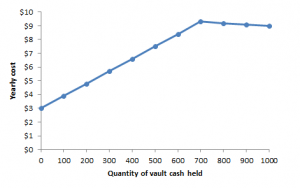Submitted by JP Koning via Moneyness blog, Negative interests rates are the shiny new thing that everyone wants to talk about. I hate to ruin a good plot line, but they’re actually kind of boring; just conventional monetary policy except in negative rate space. Same old tool, different sign. What about the tiering mechanisms that have been introduced by the Bank of Japan, Swiss National Bank, and Danmarks Nationalbank? Aren’t they new? The SNB, for instance, provides an exemption threshold whereby any amount of deposits that a bank holds above a certain amount is charged -0.75% but everything within the exemption incurs no penalty. As for the Bank of Japan, it has three tiers: reserves up to a certain level (the ‘basic balance’) are allowed to earn 0.1%, the next tier earns 0%, and all remaining reserves above that are docked -0.1%. But as Nick Rowe writes, negative rate tiers—which can be thought of as maximum allowed reserves—are simply the mirror image of minimum required reserves at positive rates. So tiering isn’t an innovation, it’s just the same old tool we learnt in Macro 101, except in reverse.
No, the novel tool that has been created is what I’m going to call a cash escape inhibitor.
Consider this. When central bank deposit rates are positive, banks will try to minimize storage of 0%-yielding banknotes by converting them into deposits at the central bank.
Articles by jp_koning
Central Banks Shiny New Tool: Cash-Escape-Inhibitors
February 29, 2016Submitted by JP Koning via Moneyness blog, Negative interests rates are the shiny new thing that everyone wants to talk about. I hate to ruin a good plot line, but they’re actually kind of boring; just conventional monetary policy except in negative rate space. Same old tool, different sign. What about the tiering mechanisms that have been introduced by the Bank of Japan, Swiss National Bank, and Danmarks Nationalbank? Aren’t they new? The SNB, for instance, provides an exemption threshold whereby any amount of deposits that a bank holds above a certain amount is charged -0.75% but everything within the exemption incurs no penalty. As for the Bank of Japan, it has three tiers: reserves up to a certain level (the ‘basic balance’) are allowed to earn 0.1%, the next tier earns 0%, and all remaining reserves above that are docked -0.1%. But as Nick Rowe writes, negative rate tiers—which can be thought of as maximum allowed reserves—are simply the mirror image of minimum required reserves at positive rates. So tiering isn’t an innovation, it’s just the same old tool we learnt in Macro 101, except in reverse.
No, the novel tool that has been created is what I’m going to call a cash escape inhibitor.
Consider this. When central bank deposit rates are positive, banks will try to minimize storage of 0%-yielding banknotes by converting them into deposits at the central bank.

